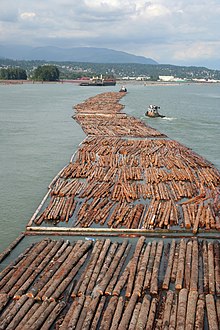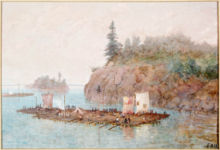Timber rafting



Timber raftingis a method of transporting felled tree trunks by tying them together to makerafts,which are then drifted or pulled downriver, or across a lake or other body of water. It is arguably, afterlog driving,the second cheapest means of transporting felledtimber.Both methods may be referred to as timber floating. The tradition of timber rafting cultivated in Austria, the Czech Republic, Germany, Latvia, Poland and Spain was inscribed onUNESCO Representative List of the Intangible Cultural Heritage of Humanityin 2022[1]
Historical rafting
[edit]
Unlike log driving, which was a dangerous task of floating separatelogs,floaters or raftsmen could enjoy relative comfort of navigation, with cabins built on rafts, steering by means ofoarsand possibility to make stops. On the other hand, rafting requires wider waterflows.
Timber rafts were also used as a means of transportation of people and goods, both raw materials (ore,fur,game) and man-made.
Theophrastus(Hist. Plant.5.8.2) records how theRomansimportedCorsicantimber by way of a huge raft propelled by as many as fiftymastsandsails.[2]
This practice used to be common in many parts of the world, especially North America and on all main rivers of Germany. Timber rafting allowed for connecting large continental forests, as in south western Germany, via Main, Neckar, Danube and Rhine with the coastal cities and states. Early modern forestry and remote trading were closely connected. Large pines in the black forest were called "Holländer," as they were traded to the Netherlands. Large timber rafts on the Rhine were 200 to 400m in length, 40m wide and consisted of several thousand logs. The crew consisted of 400 to 500 men, including shelter, bakeries, ovens and livestock stables.[3]Timber rafting infrastructure allowed for large interconnected networks all over continental Europe. The advent of the railroad, steam boat vessels and improvements in trucking and road networks gradually reduced the use of timber rafts. It is still of importance in Finland. In Spain, this method of transport was used in the Ebro, Tajo, Júcar, Turia and Segura rivers, mainly and to a lesser extent in the Guadalquivir. There is documentary evidence of these uses as early as the sixteenth century, and its use was extended until the middle of the 20th century. In Russia, the use of elaborate timber rafts calledbelyanacontinued into the 1930s.
Construction
[edit]

Timber rafts could be of enormous proportions, sometimes up to 600 metres (2,000 ft) long, 50 metres (160 ft) wide, and stacked 2 metres (6 ft 7 in) high. Such rafts would contain thousands of logs. For the comfort of the raftsmen - which could number up to 500 - logs were also used to buildcabinsandgalleys.Control of the raft was done byoarsand later on bytugboats.
Raft construction differs depending on the watercourse. Rocky and windy rivers saw rafts of simple, yet sometimes smart, construction. For example, the front parts of the logs were joined together by wooden bars, while the rear parts were loosely roped together. The resulting slack allowed for easy adaptation for narrow and windy waterbeds. Wide and quiet rivers, like theMississippi River,allowed huge rafts to travel incaravansand even be chained into strings.
These type of constructed log rafts used for timber rafting over long distances by waterways to markets of large populations appeared on the Atlantic coast about 1883. They were there sometimes referred to as Joggins-Leary log ships because they were financed by businessman James T. Leary and originated atJoggins, Nova Scotia.[4][5]They seem also to have been employed on theRhine Riveras early as September 14, 1888.[6]Their use on the Pacific coast was first contemplated by the capitalistsJames Mervyn Donahueof theSan Francisco and North Pacific RailroadandJohn D. Spreckelsof theSan Diego and Arizona Railwaywhen they formed thePacific westcoastJoggins Raft Companyon September 21, 1889.[7]
In the southeastern United States
[edit]

Rafting was a principal method of transporting timber in the southeastern United States but, except on theMississippi River,rafts were necessarily smaller than those described above. On Georgia’sAltamaha River,for example, the maximum width was about forty feet (12 m), that being the widest that could pass between the pilings of railroad bridges. Maximum length was about 250 feet (76 m), that being the longest that could navigate The Narrows, several miles of the river that were not only very narrow but also very crooked. Each raft had two oars forty to fifty feet long, one in the bow, the other at the stern. The oars were for steering, not propelling, the raft. The minimum raft crew was two men, the pilot who usually manned the stern oar, and his bow hand. Rafts usually had a lean-to shack for shelter and a mound of dirt for a hearth to warm by and cook on. The timber rafts on the Altamaha delivered logs to the port ofBrunswick, Georgia,where they were loaded onto timber schooners and transported to international markets likeLiverpool,Rio de Janeiro,andHavana.[8]Rivermen assigned colorful names to the various features and hazards along their route down the Atamaha. Among the many "riverman monikers" wasOld Hell Bight,where the river marks the border betweenLong Countyto the north andWayne Countyto the south, and is a particularly troublesome bend, with associated dangerous currents, where a pilot and crew might lose "their wages, their timber, and occasionally their lives"[9][10][11]
Most rafts were sharp-chute, that is, V-bowed, rather than square-bowed. Raftsmen had learned that with a V-bow a raft was more likely to hold together and glance off if it drifted out of control and hit the river bank. As one old-time raftsman put it: “With a square bow you were compelled to hold the raft in or near the middle of the river: if it butted the hill it would come to pieces. The sharp-chute could be put together so it would not come apart. And it saved a lot of hard work. Raftsmen didn’t mind letting it go to the hill. They’d say: ‘Let’er shoot out.’”
Rafts were assembled in sections. Each section was made up of round or squared timbers, all of the same length except for the outside, or “boom logs,” which extended aft a few feet to enclose the following section. Thus the sections were coupled together. A fairly typical raft would be one of three, four or five sections, each section having timbers twenty to thirty feet in length.
Most rafts were made up of squared timbers, either hewn square by hand or sawn square by upcountry sawmills. Some timbers were carefully, smoothly hewn, and there was a demand for them, especially in England, after steam sawmilling became common. On the Altamaha, for many years during the rafting era, most rafts were made up of “scab” timber, that is, logs roughly squared by broad ax for tighter assembly and for gang sawmills which could cut flat-face timber only.
Although, on the Altamaha, there was rafting to some extent before the Civil War and after World War I, the Altamaha’s rafting era is generally considered to have been the years between those wars. During those years,Darien,a town at the mouth of the river with a population of perhaps a couple of thousand, was a major international timber port. Reports of exports from Darien were included in the New York Lumber Trade Journal along with reports of exports from such large ports as New Orleans, Mobile, Jacksonville, Savannah, Charleston, and Norfolk.
In Canada, down the current of Quebec's rivers
[edit]
The timber was transported by floating, down the current of the rivers, which required the work of cages and log drivers (Cajeux - Draveurs). The first types of trees cut were — Pin blanc L. —Pinus strobus.— White pine (eastern white pine)., shipped toGreat Britain.
- The cageux, this Ulysses of theSt. Lawrence,St-Maurice,Batiscan,Saguenay,Jacques-Cartier,Sainte-Anne (Les Chenaux)as exemples, was responsible for assembling the rafts and piloting the huge wooden train made of squared pine — also called a cage — to a port of embarkation.
- The log driver, a daring tightrope walker of the rivers, was responsible for controlling the free floating of cut tree trunks that were thrown into a watercourse in order to reach a sawmill or a pulp and paper mill.[13]
In Finland
[edit]While the more technically challenginglog drivingdown rivers declined from the 1960s and mostly ended by the early 21th century, timber rafting has continued to some degree along lakes.UPMandMetsähallituscontinue timber rafting in theVuoksi-Saimaabasin.[14]Timber rafting has experienced a resurgence following theRusso-Ukrainian War.Timber imports from Russia stopped, requiring their replacement with more timber to be procured from the upper reaches of Saimaa, while the Finnish truck fleet was however not large enough to accommodate this. Thus, timber rafting took its place. Timber rafting is 20% cheaper than transport by truck or rail. It is also environmentally friendly, with much lower greenhouse gas emissions than truck transport.[15]
See also
[edit]- Barrier Boat
- Belyana
- Benson raft
- Kallai
- Log boom
- Log driving
- Log flume
- Timber slide
- Wood economy
- Eight Hundred Leagues on the Amazon,novel by Jules Verne about a timber raft trip down the Amazon River.
References
[edit]- ^"UNESCO - Timber rafting".
- ^Casson, Lionel(1995): "Ships and Seamanship in the Ancient World", Johns Hopkins University Press,ISBN978-0-8018-5130-8,p. 4, fn. 2
- ^Beschreibung eines großen Rheinfloßes
- ^"A Big Raft Comes By Sea",New York Times,August 25, 1883
- ^"The Joggins Log Raft".Waterbury Evening Democrat.Waterbury, Connecticut. August 13, 1888. p. 1 – viaNewspapers.com
 .
.
- ^"Notes and Comments".The Newcastle Weekly Courant.Newcastle, England. September 14, 1888. p. 2 – viaNewspapers.com
 .
.
- ^"To Handle Big Lumber Rafts".The New York Times.New York, New York. September 22, 1888. p. 5 – viaNewspapers.com
 .
.
- ^Mark V. Wetherington (1 September 2001).The New South Comes to Wiregrass Georgia, 1860-1910 - Timber Is King.Univ. of Tennessee Press. pp. 113–114.ISBN978-1-57233-168-6.
- ^Delma E. Presley (June 4, 2013)."Rafting Folklore".New Georgia Encyclopedia.Retrieved25 June2020.
- ^John H. Goff (1 December 2007).Placenames of Georgia.University of Georgia Press. pp. 403–404.ISBN978-0-8203-3129-4.
- ^U.S. Geological Survey Geographic Names Information System: Old Hell Lake
- ^Elizabeth A. Moffatt, Marie-Claude Corbeil (2007)."The Painting Materials and Techniques of Cornelius Krieghoff (1815-1867)"(PDF).Department of Canadian Heritage and the Art Gallery of Ontario. p. 15.Retrieved2023-12-21.
Autumn and winter landscapes, portrayals of Aboriginal people and depictions of life in rural Quebec
- ^"200 years of exploits Cageux et draveurs".On the road to the historic motion of the National Assembly of Quebec: 200 years of exploits: cageux et draveurs(in French). Bibliothèque et Archives nationales du Québec. 2021. p. 380.Retrieved2023-12-21.
At the time of the great voyages of exploration, the First Peoples provided assistance essential for Europeans to survive and settle in these lands
- ^"Uittoreittien maa".13 April 2023.
- ^"Metsäteollisuus kaivoi satoja vuosia vanhan kuljetustavan naftaliinista – tältä näyttää, kun 938 tukkinippua seilaa Saimaalla jonossa".15 July 2022.
Further reading
[edit]- Bowering, IanHow timber rafts ran the Long Sault rapidsin Standard Freeholder (October 8, 1993) accessed at Cornwall Public Library, Ontario[1]June 21, 2006
- Morrison, Carlton A.Running the River: Poleboats, Steamboats & Timber Rafts on the Altamaha, Ocmulgee, Oconee & Ohoopee.Available in various Georgia (U. S.) libraries and from the publisher's website:' 'www.saltmarshpress.com
External links
[edit]![]() Media related toTimber floatingat Wikimedia Commons
Media related toTimber floatingat Wikimedia Commons
- International Timber-Raftsmen Associationwith member organizations in 11 countries
- Rafting on the Drina River (1951) - BH Film - Official chanal
